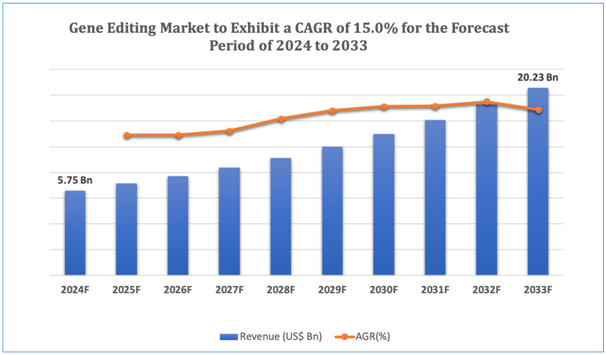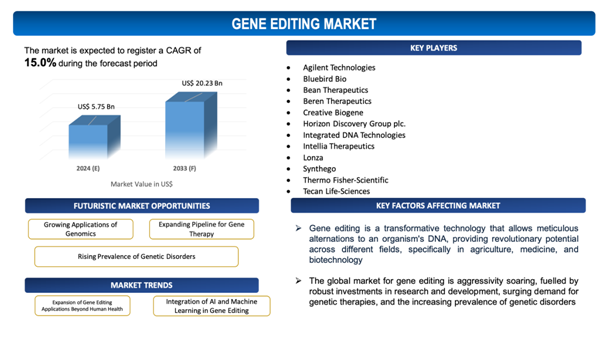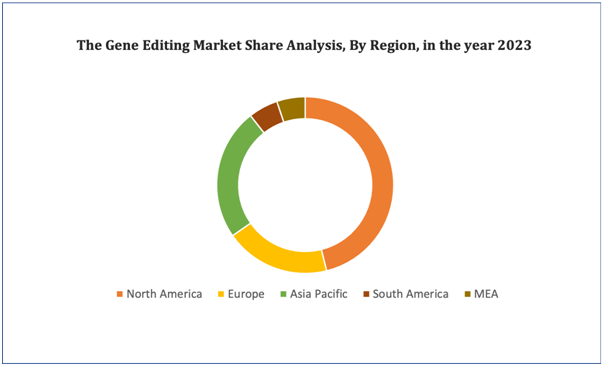Gene Editing Market Overview
The global gene editing market is estimated to be worth over USD 20.23Bn in 2033 and is expected to grow at CAGR of15.0% during the forecast period (2024-2033).
Gene editing is a transformative technology that allowsmeticulousalternations to an organism's DNA, providingrevolutionary potential across different fields, specifically in agriculture, medicine, and biotechnology. The most exceptional gene-editing tool, CRISPR-Cas9, has essentially advanced the capability to edit genes precisely and efficiently. This technology enables for targeted changes in the genome, supporting the correction of genetic defects, the improvement of desirable traits, and the analysis of gene functions with unparalleled precision.
The global market for gene editing is aggressivity soaring, fuelled by robust investments in research and development, surging demand for genetic therapies, and the increasing prevalence of genetic disorders. In medicine, gene editing holds commitment for managing a broad range of diseases, comprisinggenetic disorders like cystic fibrosis and sickle cell anemia, cancer, and even infectious ailments such as HIV. Clinical trials utilizing CRISPR and other gene-editing technologies are progressing, with some therapies already exhibitingfavorable results in early-phase studies.
In agriculture, gene editing is being employed to develop crops that are more resistant to diseases, pests, and environmental stresses, thusimproving food security and sustainability. It also allows the creation of livestock with enhanced health and productivity traits. These applications are critical for addressing global challenges associated with food production and environmental conservation.
The market's growth is further proliferated by favorable regulatory environments in various countries, which are developing frameworks to support the safe and ethical use of gene-editing technologies. Collaborations between academic institutions, biotech companies, and governmental bodies are also fostering innovation and commercialization in this field.
Regardless of its potential, gene editing raises ethical and safety concerns that need to be carefully regulated. Issues such as off-target effects, long-term impacts, and equitable access to these technologies are crucial areas of continuous research and debate. Nonetheless, the developments and growing adoption of gene editing position it as a foundation technology for the future of healthcare and agriculture, acceleratingnotable market growth worldwide.
Figure 1. Gene Editing: Market Size

Get more details on this report - Request Free Sample
Key Market Insights
The global gene editing market is witnessingstrong growth, accelerated by developments in technologies such as CRISPR-Cas9, TALENs, and zinc finger nucleases (ZFNs). These technologies have transformed the accuracy and efficiency of genetic modifications, making gene editing more practical and accessible across different sectors. Significant developments comprise the development of CRISPR-based therapies into clinical trials, displayingfavorableoutcomes in managing genetic disorders like sickle cell anemia and beta-thalassemia, and even targeting cancers.
The market is marked by significant investments from both public and private sectors, with several academic institutions, biotech companies, and research organizations actively exploring gene-editing applications. Strategic collaborations and partnerships are common, focusing onpropelling research and commercialization efforts. The agricultural field is also a significant beneficiary, using gene editing to develop crops with enhanced traits such as disease resistance, enhanced yield, and climate resilience.
Novel technologies are persistently emerging, improving the safety, specificity, and efficiency of gene editing. Advancements such as base editing and prime editing provideinnovative techniques for making accurate genetic changes without causing double-strand breaks, thus minimizing potential off-target effects and enhancing safety profiles.
Regulatory frameworks are evolving to facilitate the ethical and safe application of gene editing, with various countries implementing guidelines to manage clinical and agricultural uses. This regulatory support is crucial for fostering market growth and ensuring public trust.
Market Dynamics
Market Drivers
Growing Applications of Genomics
Genomics, the inspection of an organism's whole range of DNA, comprising all of its genes, offerscriticalforesights into the genetic basis of traits, diseases, and biological functions. As the understanding of genomics broadens, the demand for meticulous gene editing tools that can manipulate the genome to assess gene function, treat genetic disorders, and develop targeted therapies surges. Gene editing technologies like TALENs, CRISPR-Cas9, and zinc finger nucleases (ZFNs) are in the lead of this progress, allowing researchers to make particularalterations to the DNA sequence with exceptional efficiencyand accuracy.
In healthcare, the incorporation of genomics with gene editing promotes the development of personalized medicine approaches, where treatments are customized to an individual's genetic profile. This cooperationenables for the correction of mutations responsible for genetic disorders, the development of novel cancer therapies, and the improvement of immune responses to infectious disorders. The growing prevalence of genetic testing and sequencing further propels the demand for gene editing, as more genetic data becomes accessible for therapeutic exploitation.
In agriculture, genomics applications accelerate the creation of genetically advanced crops with enhancedattributes such as better yield, disease resistance, and climate resilience. This not only improves food security but also supports sustainable agricultural practices. The soaring prominence of genomics in understanding and acknowledging global challenges, from human health to food production, substantiallypropels the gene editing market. As a consequence, the continuous advancements in genomics are essential for the innovation and expansion of the global gene editing market, encouraging a greater integration of these technologies into various industries.
Market Restraints
With regard to numerous advantages of gene editing, the market faces several challenges due to the unique characteristics and requirements associated with these potent pharmaceutical products. Some of the key market challenges include:
- Ethical and Regulatory Challenges: The global gene editing market witnessessubstantial ethical and regulatory challenges that can impede its growth. Issues about the potential misuse of gene editing technologies, such as creating "designer babies" or unforeseen genetic modifications, raise ethical dilemmas. Regulatory bodies across various countries have altering and often stringent guidelines, creating a complicated and fragmented regulatory panorama. This can postpone the approval process for new therapies and intensify compliance costs for companies, thuslimiting market expansion.
- Technical Limitations and Off-Target Effects: Regardless of theprogresses, gene editing technologies still experience technical restrictions, specifically concerning off-target effects where inadvertentcomponents of the genome may be changed. These off-target alternations can result inaccidental consequences, comprising the potential advancement of new health problems or the worsening of existing conditions. The technical challenges related to ensuring safety and precision in gene editing can deter the adoption and application of these technologies, affecting market growth. Persistent research and development are needed to enhance the reliability and specificity of gene editing tools, which can be resource-intensive and time-consuming.

Get more details on this report - Request Free Sample
Market Opportunity
Expanding Pipeline for Gene Therapy
Gene therapies, which includechanging the genetic material within a patient's cells to treat or cure ailments, are increasingly dependent on state-of-the-art gene editing technologies like TALENs, CRISPR-Cas9, and zinc finger nucleases (ZFNs) for their development and implementation. As the number of gene therapy candidates in clinical trials increases, so does the demand for accurate and efficient gene editing tools to create these therapies. This developing pipeline is fuelled by the pressingneed foradvanced treatments for anextensive range of cancers, genetic disorders, and other chronic ailments that currently have limited or no effective therapies.
The growing number of gene therapy projects in preclinical and clinical stages propels the demand for gene editing technologies, fostering significant investment and innovation in the field. Pharmaceutical and biotechnology companies are heavily investing in the research and development of gene therapies, associating with gene editing firms to enhance their capabilities. These collaborations and investments are crucial for conquering technical barriers and propelling the shift from research to commercial therapies.
In addition, successful development and approval of gene therapies can lead the way for wider acceptance and adoption of gene editing technologies, building a positive feedback loop that further propels market growth. As regulatory agencies become more familiar with gene editing tools through the gene therapy approval process, regulatory pathways are also likely to become more streamlined, supportingquicker development and commercialization. For this reason, the expanding pipeline for gene therapy substantiallyimproves the growth prospects of the global gene editing market by fuelling technological developments, investment, and market acceptance.
Market Trends
- Expansion of Gene Editing Applications Beyond Human Health: A significant trend is the development of gene editing applications beyond conventional human health uses into fields such as agriculture, industrial biotechnology, and environmental science. In agriculture, gene editing is being utilized to develop crops with enhanced traits, such as better yields, improved nutritional content, and resistance to diseases and environmental stresses. In industrial biotechnology, gene editing is applied to engineer microorganisms for the production of biofuels, bioplastics, and other sustainable materials. In addition, gene editing is being explored for environmental applications, such as creating organisms capable of bioremediation or controlling invasive species. This variegation of applications widens the market potential for gene editing technologies, appealing a broaderscale of investments and fostering cross-industry collaborations.
Gene Editing Market: Key Segments
By Product & Services
- Reagents & Consumables
- Software & Systems
- Services
By Technology
- Clustered Regularly Interspaced Short Palindromic Repeats (CRISPR)
- Transcription Activator-Like Effector Nuclease (TALEN)
- Zinc Finger Nuclease (ZFN)
- Antisense
- Other Technologies
By Application
- Cell Line Engineering
- Genetic Engineering
- Drug Discovery & Development
- Other Applications
By End-user
- Pharmaceutical and Biotechnology Companies
- Academic and Research Institutes
- Other End Users
By Key Geographical Regions
- North America
- Europe
- Asia-Pacific
- Middle East and Africa
- South America
Figure 4. Gene Editing Market: Distribution by Region

Get more details on this report - Request Free Sample
Gene Editing Market: Regional Analysis
North America is anticipated to continue its dominance throughout the forecast period. The demand for gene editing medicines is fuelled by greater public and private funding, substantial vital actors, the region's cultured healthcare system, and the increased prevalence of genetic diseases. Patients and healthcare professionals have shownhuge interest in the possibility of managing these illnesses. The area has a strong research infrastructure with a concentration of internationally renowned universities, research centres, and biotechnology firms specializing in genetic research and technology development. It has a blooming investment scene, with robust capital going to businesses in biotechnology and gene editing.
Leading Gene Editing Developers
Industry Trends and Global Forecasts, 2023-2035 report features an extensive study of the current market landscape, market size and future opportunities associated with the Gene Editingmarket, during the given forecast period. Further, the market report highlights the efforts of several stakeholders engaged in this rapidly emerging segment of the biopharmaceutical industry. Key takeaways of the Gene Editingmarket are briefly discussed below.
The report includes the list of players operating in the global gene editingmarket. Some of the key players include:
- Agilent Technologies
- Bluebird Bio
- Bean Therapeutics
- Beren Therapeutics
- Creative Biogene
- Horizon Discovery Group plc.
- Integrated DNA Technologies
- Intellia Therapeutics
- Lonza
- Synthego
- Thermo Fisher-Scientific
- Tecan Life-Sciences
Gene Editing Market: Key Developments
- In April 2024, Regeneron Pharmaceuticalsannounced that it will use Mammoth Biosciences’ CRISPR-based ultracompact gene editing platform to develop in vivo therapies for tissues and cell types beyond the liver, through a collaboration that will expand Regeneron’s genetic medicines presence with more gene editing programs.The collaboration is designed to combine Mammoth’s platform with Regeneron’s effort to develop adeno-associated viral vectors (AAVs) that use antibody-based targeting to enhance delivery of genetic medicine payloads to specific tissues and cell types.
- In September 2023, Mission Bio, a leader in single-cell multi-omic solutions for precision medicine, launched the Tapestri® Genome Editing Solution. Designed to meet the pressing need for high-resolution analysis of genome editing, this first-of-its-kind solution addresses a long-standing gap in advanced therapy development, disease modeling, and functional genomics.
Scope of the Report
The market report presents an in-depth analysis of the various firms / organizations that are engaged in this market, across different segments, as defined in the below table:
|
|
Key Report Attributes |
Details |
||
|
|
Base Year |
2023 |
||
|
|
Forecast Period |
2024-2033 |
||
|
|
CAGR (2024-2033) |
15.0% |
||
|
|
Products & Services |
|
||
|
|
Technology |
|
||
|
|
Application |
|
||
|
|
End-Users |
|
||
|
|
Key Geographical Regions |
|
||
|
Key Companies Profiled |
|
|
||
